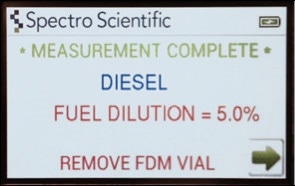One of the key failure modes of lubricants in internal combustion engines is the presence of fuel contamination in them, which reduces the lubricant’s load carrying ability by lowering its viscosity.
Engine components experience severe wear if fuel dilution problems in lubricants are neglected. Increased sludge deposits and oil oxidation, lubricant seizure and breakdown, and explosion caused by light-end, highly volatile hydrocarbons, are other fuel dilution failure mechanisms.
Fuel Dilution Analysis Methods
According to ASTM D3524, D3525, and D7593 methods, gas Chromatography (GC) is the most commonly used direct methods for fuel dilution analysis on lubricants, yielding precise results. However, these GC analysis methods are both cost and time intensive and need the involvement of skilled operators, making them suitable only for laboratories handling high volumes.
FT-IR spectroscopy, flash point testing and viscosity are commonly used indirect methods for fuel dilution measurement. All these methods have their own disadvantages, thus facing difficulty in achieving in accurate results.
The New Q6000 portable Fuel Dilution Meter
The new Q6000 portable Fuel Dilution Meter (FDM) from Spectro Scientific provides a portable, battery-operated, on-site fuel dilution measurement solution that avoids any catastrophic engine failure by yielding highly accurate results rapidly (Figure 1).

Figure 1. The new Q6000 portable FDM
The Q6000 FDM pierces a disposable sample vial’s cap using an innovative patent-pending fang design and draws in the headspace from the sample vial. The headspace flows above a Surface Acoustic Wave sensor that detects the fuel vapor with a range of 0 - 15%.
At equilibrium, the extent of fuel dilution in the oil varies proportionally to the fuel vapor present in the headspace of a closed sample vessel, according to Henry's law (Figure 2)

Figure 2. Henry’s law as it applies to fuel dilution.
Comparative Study Between GC Reference Method and the Q6000 FDM
This study used three sets of lubricant calibration samples and test samples consisting of different amounts of diesel fuel dilution (Table 1). The Q6000 FDM was calibrated using the calibration samples before analyzing the test samples (A0 and B0). The samples were also analyzed at an ISO 17025 accredited commercial laboratory using GC as outlined by the modified ASTM D3524 method.
Table 1. Diesel fuel dilution calibration standards and test samples used in the comparative study between the Q6000 FDM and GC methods
| SAMPLE |
TYPE |
N |
| A0 |
Calibration |
New Mobil Delvac 1 ESP 5W-40 oil, no soot present, 5% diesel fuel dilution |
| A1 |
Test |
Used Mobil Delvac 1 ESP 5W-40 oil, no soot present, unknown diesel fuel dilution |
| A2 |
Test |
Used Mobil Delvac 1 ESP 5W-40 oil, significant soot present, unknown diesel fuel dilution |
| A3 |
Test |
Used Mobil Delvac 1 ESP 5W-40 oil, significant soot present, unknown diesel fuel dilution |
| B0 |
Calibration |
New Esso Racing 20W-50 oil, no soot present, 5% diesel fuel present |
| B1 |
Test |
Used Esso Racing 20W-50 oil, no soot present, diesel added to 13.4% fuel dilution |
It is possible to calibrate the Q6000 FDM using any known sample within the detection range. A graduated disposable pipette was used to dispense about 0.5mL of sample onto the felt disc within the FDM sample vial. Samples were made in triplicate and measured consecutively (Figure 3).

Figure 3. FDM sample vial and dispensing the oil sample onto the felt disc using a graduated disposable pipette.
The Q6000 FDM allows preparing up to five samples simultaneously for subsequent analysis. After capping the vials, they are allowed to reach equilibrium and then analyzed on the Q6000 FDM. The touch screen interface with audio and display instructions facilitates simple operation for each step.
The results can be read on the display within two minutes after each sample measurement (Figure 4). The comparative study results are summarized in Table 2, showing a good agreement between the Q6000 FDM results and the GC reference method results.

Figure 4. Results screen on the Q6000 FDM showing the % fuel dilution found for a sample using a diesel calibration program.
Table 2. The % diesel fuel dilution results for each test sample
| % DIESEL FUEL DILUTION |
| SAMPLE |
OIL TYPE |
CONDITION |
Q6000 FDM(% DIESEL FUEL) |
GC ANALYSIS(% DIESEL FUEL) |
| A1 |
Mobil Delvac 1 ESP 5W-40 |
Used, Not Sooty |
1.8 |
1.9 |
1.9 |
1.98 |
| A2 |
Mobil Delvac 1 ESP 5W-40 |
Used, 1.2% soot |
0.3 |
0.2 |
0.4 |
0.22 |
| A3 |
Mobil Delvac 1 ESP 5W-40 |
Used, 1.2% soot |
1.8 |
1.9 |
1.9 |
1.80 |
| B1 |
Esso Racing 20W-50 |
New oil, known 13.4% |
13.9 |
13.1 |
13.0 |
12.95 |
The higher end of the measurement range on the Q6000 FDM was tested by preparing a calibration standard of 5% (B0) and a known test sample of 13.4% diesel fuel (B1) in Esso Racing 20W-50. For the sample B1, the Q6000 FDM results match accurately with the gravimetric values and show good agreement with the GC reference method results.
The Q6000 FDM shows outstanding repeatability with < 5% RSD. This demonstrates the instrument’s capability to yield reliable on-field measurements that are in good agreement with the referee laboratory method.
Conclusion
The Q6000 FDM performs fuel dilution analysis on a variety of oils without the need for solvents. The user-friendly, portable device provides accurate and reliable results within a couple of minutes. It is easier to adapt the measurement by single point calibration to various oil types. Compared to the GC reference method, the Q6000 FDM provides an economical method that can be performed by operators of all skill levels.

This information has been sourced, reviewed and adapted from materials provided by AMETEK Spectro Scientific.
For more information on this source, please visit AMETEK Spectro Scientific.